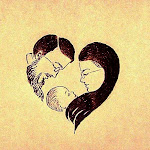Once more, Ochlophobist has impressed me with a brilliant post, this one on art. It comes out of a dialogue involving Daniel Matsui from The Lion and the Cardinal and Arturo from The Sarabite, and is chiefly a reaction to Arturo. Arturo's reasoning frequently gives me headaches, so I appreciated Ochlophobist's response.
There is a lot to process, a lot of meat in his post, but I am not going to examine it piece by piece. Rather I am going to simply react to a couple comments he makes. More in keeping with my patience levels.
1) Classical art is not the model for a Christian art (paragraph 9). Although classical academies today and the preponderance of artists and art critics from the time of the Renaissance to the time of the Impressionists regard and regarded Greco-Roman art as the be-all and end-all of truth and beauty, it is a truth worth noting that the Fathers of the Christian faith did not feel so. Instead, they guided us into our respective iconographies (Western and Eastern) for the sake of adhering to theological truth and beauty, for the sake and purpose of forming the people of God into Saints of God, and to praise God with brush and pen.
As a sidebar, modern art did not come into being until the salons - the guildhalls of the art world - crumbled under the impact of Impressionism, leaving no larger principle to guide them or keep them from deeper error. Hitherto it was classical art that was the larger principle.
2) Catharsis in modern art is akin to the release of orgasm (paragraph 10). In his critique of catharsis in art, Ochlophobist says that catharsis is foreign to Orthodoxy, and then he proceeds to define this catharsis as orgasmic, ecstatic. Elsewhere he goes further and links post-Renaissance art to what he calls pansexualism.
I am not fully with him on this point, mostly because I don't understand the bit about pansexualism. However, I think I get the bit about catharsis. In my art classes we were not urged to paint out our feelings, but I saw a lot of that in the university program I didn't take. There it was de rigeur to work in tar and newspaper clippings. I still remember the "deeply meaningful" exhibition to which a friend of mine invited me, involving tar, dismembered dolls held together by wires, and her own blood. Apparently she had expressed or channelled her inner pain. I wasn't happy for her - I was horrified, as this was manifestly not art, being neither true, beautiful, nor good.
Despite not being trained in cathartic painting, I find that most of the artwork that I have done was a response to strong emotion (passion?) and not disciplined, not work. This I would feel is a great weakness - though I haven't gone so far as to identify it as unOrthodox.
3) Rouault is the one big exception (paragraph 11). I have never chatted with either Ochlophobist or Mr. Mitsui, but I would like to. Having waded through modern art (no matter the precise appellation: modern, post-modern, cubist, etc.), I would have to reject almost all of it. Certainly that which is held up as exemplary - with one exception: Georges Rouault. Unlike Ochlophobist, I do not like Rouault's clowns and whores, but I am moved by his images of Christ, especially Crucifixion, which to me has all the feel of a stained-glass window.
As for the rest? So much trash. I remember admiring Dali at one point in my life. Then I read a 600-page volume of his collected works. The man was an obsessive pervert whose nightmarish images of clocks, horses, and breasts should have had him locked up somewhere. A few years later, and wiser, I visited a Picasso exhibit - under duress - with a friend. He thought it would be cultural, I think. Afterwards, we looked at each other with horror. Picasso was no genius, unless it was a diabolical genius. The man was evil, with every bestial thought made tangible through his "art" - the exhibit left us feeling soiled. Art cannot be art unless it be beautiful, unless it be true, and modern art has failed us in these two regards. And we have failed art, by not demanding better.
4) Arturo claims that a love of medieval iconography comes from a Protestant aesthetic (paragraph 12). This assertion just horrifies me - it insinuates that iconography is sterile, beauty-hating, or iconoclastic. As a sidebar, not all Protestants are iconoclastic or beauty-hating, but then, they usually aren't terribly Protestant either.
5) Baroque/Italianate/modern Catholic folk art are not true, if only because they betray an overt religious eroticism (paragraphs 18, 19). My agreement here is experientially based. When I was in my late teens I was - somewhat understandably - consumed by a love of the erotic, and nowhere was this more manifested than in my artwork and in the artists I most admired and emulated: Klimt, Rossetti, and Bellini. In Bellini's case, it was the clearly erotic, even orgasmic, Ecstasy of St. Theresa, which caught my attention, and which, while wonderfully rendered and beautiful, revealed something perverse and false. Not all Baroque artists (and their descendants) are as obviously untrue, but I can see this tendency to varying degrees.
As for modern Catholic folk art, I would have to make an exception for Our Lady of Guadalupe, which is to my eyes more iconic than erotic.
6) Schoenberg's gravestone is perhaps the best example of a Protestant aesthetic (paragraph 21). Iconoclastic? Beauty-hating? Sterile? Yep. As a broad caricature, this statement works for me.
I will come back to this post - to paragraph 14 in particular - but a small child beckons, and that insistently.
- V.
The Tower and the Ruin, by Michael Drout
3 days ago



No comments:
Post a Comment